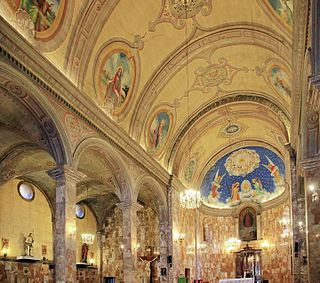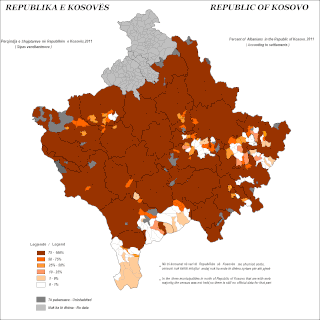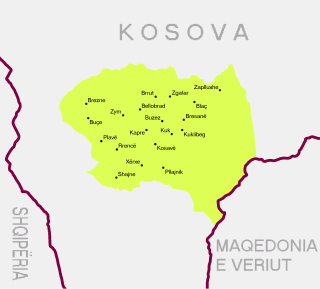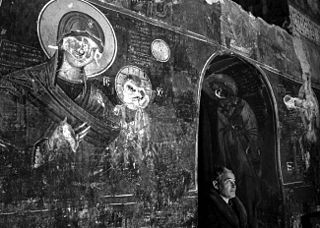This article includes information on the demographic history of Kosovo.

Prizren is the second most populous city and municipality of Kosovo and seat of the eponymous municipality and district. It is located on the banks of the Prizren River between the foothills of the Sharr Mountains in southern Kosovo. Prizren experiences a continental climate with some mediterranean influences.

Novo Brdo or Novobërda and Artanë, is a town and municipality located in the Pristina district of Kosovo. According to the 2011 census, it has a population of 6,729 inhabitants. The center of the municipality is the village of Bostane. The region is especially known for its role in mining during medieval times, in particular after the construction of the Novo Brdo Fortress by Stefan Milutin to house Saxon miners who were brought in the region.

The Visoki Dečani Monastery is a medieval Serbian Orthodox Christian monastery located near Deçan, Kosovo. It was founded in the first half of the 14th century by Stefan Dečanski, King of Serbia.

The Diocese of Prizren and Pristina is a Latin Church ecclesiastical territory or diocese of the Catholic Church in Kosovo. It is centered in the city of Prizren. It was erected as an apostolic administration in 2000, after being split from the Diocese of Skopje and Prizren, and elevated to the rank of diocese in 2018.

The Albanians of Kosovo, also commonly called Kosovo Albanians, Kosovan Albanians or Kosovars, constitute the largest ethnic group in Kosovo.

Opolje is a region in the southern part of the municipality of Prizren in southern Kosovo. The region has 19 villages mainly inhabited by Kosovo Albanians.

A District is the highest level of administrative divisions of Kosovo. The districts of Kosovo are based on the 2000 Reform of the UNMIK-Administration.

Christianity in Kosovo has a long-standing tradition dating to the Roman Empire. The entire Balkan region had been Christianized by the Roman, Byzantine, First Bulgarian Empire, Serbian Kingdom, Second Bulgarian Empire, and Serbian Empire till 13th century. After the Battle of Kosovo in 1389 until 1912, Kosovo was part of the Muslim Ottoman Empire, and a high level of Islamization occurred. During the time period after World War II, Kosovo was ruled by secular socialist authorities in the Socialist Federal Republic of Yugoslavia (SFRY). During that period, Kosovars became increasingly secularized. Today, 87% of Kosovo's population are from Muslim family backgrounds, most of whom are ethnic Albanians, but also including Slavic speakers and Turks.

Eparchy of Raška and Prizren is one of the oldest eparchies of the Serbian Orthodox Church, featuring the seat of the Serbian Orthodox Church, the Serbian Patriarchal Monastery of Peć, as well as Serbian Orthodox Monastery of Visoki Dečani, which together are part of the UNESCO World Heritage sites of Serbia.
Tourism in Kosovo is characterized by archaeological heritage from Illyrian, Dardanian, Roman, Byzantine, Serbian and Ottoman times, traditional Albanian and Serbian cuisine, architecture, religious heritage, traditions, and natural landscapes. Kosovo is situated in south-eastern Europe. With its central position in the Balkans, it serves as a link in the connection between central and south Europe, the Adriatic Sea, and Black Sea.

The Dečani chrysobulls alternatively known as the Dečani charters are chrysobulls dating to 1330–1345 that constitute the founding charters issued by the Serbian King Stefan Dečanski after the building of the monastery of Visoki Dečani was completed, in 1330. In particular, the charters contain a detailed list of landholdings and tax farming rights which the monastery held over settlements and communities in the Kingdom of Serbia, in an area which spanned from present-day southern Serbia, Kosovo, Montenegro and parts of northern Albania.
The Sanjak of Viçitrina, also known as the Pristina Pashaluk, was a sanjak of the Ottoman Empire in Rumelia, in present-day Kosovo. It was named after its administrative center Vushtrri.
Monuments of Kosovo comprise all the monuments that are located in Kosovo.

Novo Brdo Fortress is a medieval Serbian fortress in Kosovo. Its ruins are located near the town of Novo Brdo, about 40 kilometres (25 mi) east of Pristina. The fortress was built in the late 13th century by king Stephen Uroš II Milutin of Serbia to protect gold, silver, iron and lead mines which were abundant throughout the area. Novo Brdo was famous for its silver. Together with the castles of Prizren, 12 kilometres (7.5 mi) to the southwest, and Prilepac, 13 kilometres (8.1 mi) to the southeast, which guard access roads to the fortress, Novo Brdo helped form a defensive complex overlooking the lucrative mining operations. Novo Brdo was at its height during the Serbian Despotate (1402–1459), when it was the most important mining area and second most important town in Serbia. A significant number of Saxon miners, Albanian Catholics and a large Ragusan merchant colony lived within the town, which was ruled by a vojvoda, but also a governor (kefalija), because it was the seat of an administrative unit of the Despotate.

Serbian cultural and religious sites in Kosovo were systematically vandalized and destroyed over several historical periods, during the Ottoman rule, World War I, World War II, Yugoslav communist rule, Kosovo War and 2004 unrest.
In medieval Serbia a social group known as "Vlachs" existed. While the term Vlachs had more meaning, primarily denote the inhabitants of Aromanian origin and also dependent shepherds in the medieval Serbian state.

Botushë is a village in the municipality of Gjakova, District of Gjakova, southwest Kosovo. It is located near the border with Albania and is part of the Highlands of Gjakova. It is inhabited exclusively by Albanians.
The katun is a rural self-governing community in the Balkans, traditional of the living style of Albanians, Vlachs, as well as some Slavic communities of hill people. Traditionally, a katun is based on strong kinship ties and the practice of a closed farming economy based on stockbreeding, constantly moving to find pasture. The community based its organizational, political and economic activities on the decisions of a council of elders or a senior member appointed as its leader. The Albanian communities strictly followed the Kanun, their traditional customary law that has directed all the aspects of their kinship-based society.























